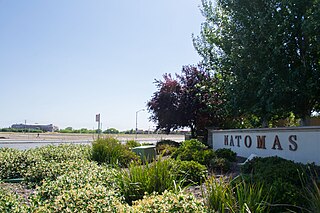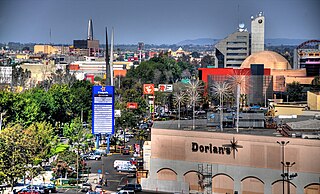
Orange County, often known by its initials O.C., is a county located in the Los Angeles metropolitan area in Southern California, United States. As of the 2020 census, the population was 3,186,989, making it the third-most-populous county in California, the sixth-most-populous in the United States, and more populous than 19 American states and Washington, D.C. Although largely suburban, it is the second-most-densely-populated county in the state behind San Francisco County. The county's three most-populous cities are Anaheim, Santa Ana, and Irvine, each of which has a population exceeding 300,000. Santa Ana is also the county seat. Six cities in Orange County are on the Pacific coast: Seal Beach, Huntington Beach, Newport Beach, Laguna Beach, Dana Point, and San Clemente.

Greater Los Angeles is the largest metropolitan area in the U.S. state of California. It encompasses five counties in Southern California extending from Ventura County in the west to San Bernardino County and Riverside County in the east, with Los Angeles County in the center, and Orange County to the southeast. The Los Angeles–Anaheim–Riverside combined statistical area covers 33,954 square miles (87,940 km2), making it the largest metropolitan region in the United States by land area. With a population of 18.5 million in 2021, it is the second-largest metropolitan area in the United States. The contiguous urban area is 2,281 square miles (5,910 km2), whereas the remainder mostly consists of mountain and desert areas.

The Irvine Company LLC is an American private company focused on real estate development. It is headquartered in Newport Beach, California, with a large portion of its operations centered in and around Irvine, California, a planned city of more than 300,000 people mainly designed by the Irvine Company. The company was founded by the Irvine family and is currently wholly owned by Donald Bren.

Downtown is the largest central business district in the city of Houston and the largest in the state of Texas, located near the geographic center of the metropolitan area at the confluence of Interstate 10, Interstate 45, and Interstate 69. The 1.84-square-mile (4.8 km2) district, enclosed by the aforementioned highways, contains the original townsite of Houston at the confluence of Buffalo Bayou and White Oak Bayou, a point known as Allen's Landing. Downtown has been the city's preeminent commercial district since its founding in 1836.

Edge city is a term that originated in the United States for a concentration of business, shopping, and entertainment outside a traditional downtown or central business district, in what had previously been a suburban residential or rural area. The term was popularized by the 1991 book Edge City: Life on the New Frontier by Joel Garreau, who established its current meaning while working as a reporter for The Washington Post. Garreau argues that the edge city has become the standard form of urban growth worldwide, representing a 20th-century urban form unlike that of the 19th-century central downtown. Other terms for these areas include suburban activity centers, megacenters, and suburban business districts. These districts have now developed in many countries.

The Irvine Spectrum Center is an outdoor shopping center developed by the Irvine Company, located in the Irvine Spectrum district on the southeast edge of Irvine, California. The mall features Nordstrom and Target department stores, a ferris wheel, and a Regal Cinemas 21-screen movie theater. Built over a 10-year period, the first phase of the center opened in 1995 and the second phase followed in 1998. The third phase was completed in 2002. The fourth and fifth phases were built and completed between 2005 and 2006. The mall was used for establishing shots of the fictional "Mall of Miami" in the Disney Channel television series Austin and Ally.

The South Coast Metro is a district in Orange County, California within the cities of Santa Ana and Costa Mesa. The area is a dense mix of residential, office, and retail developments that spreads out from the South Coast Plaza mall. It forms part of the South Coast Plaza–John Wayne Airport edge city, a concentration of business, shopping, and entertainment outside a traditional central business district. The edge city's area is defined to include John Wayne Airport, the Irvine Business Complex (IBC), The District and The Market Place shopping centers, and the University of California, Irvine campus. This larger definition extends into Newport Beach, Irvine, and Tustin.

Rancho Bernardo is a master-planned community in the northern hills of the city of San Diego, California.

Irvine is a master-planned city in southern Orange County, California, United States, in the Los Angeles metropolitan area. The Irvine Company started developing the area in the 1960s and the city was formally incorporated on December 28, 1971. The 66-square-mile (170 km2) city had a population of 307,670 at the 2020 census; it is the 63rd most populous city in the United States.

University City (UC) is a community in San Diego, California, located in the northwestern portion of the city next to the University of California, San Diego. The area was originally intended to serve as housing for the faculty of the university, hence the name.

The Platinum Triangle is a district of Anaheim, California, United States, that is undergoing transformation from a low-density commercial and industrial zone into a more urban environment with high-density housing, commercial office towers, and retail space. The 820 acres (330 ha) area undergoing this large-scale redevelopment includes the city's two major sports venues, the Honda Center and Angel Stadium of Anaheim.
John Tilghman "Til" Hazel Jr. was an American attorney and real-estate developer in Northern Virginia who is credited with developing several portions of Fairfax County, Virginia, into major commercial and residential areas from the 1960s through the present. He was instrumental in the large-scale development of Tysons, Virginia, which became one of the country's first significant edge cities.

Natomas is a community in the northwestern section of the city of Sacramento, in the U.S. state of California.

Torrey Pines is a community neighborhood of 2,600 acres (1,100 ha) in the northern coastal area of San Diego, California, residential with large areas of office space along I-5.

Zona Río is an official zone, and the main modern business district, of the city of Tijuana, Mexico.

Del Mar Heights is an upscale neighborhood near the coast in San Diego, California bordered by Solana Beach to the north, North City and Carmel Valley to the east, Del Mar to the west, and Torrey Pines to the south. I-5 forms the eastern boundary. It is noted for its hills.
Sorrento Mesa is a neighborhood in northwestern San Diego, California. It lies on a mesa with many ridges, north of Carrol Canyon Road, east of Interstate 805, west of Camino Santa Fe, and south of a canyon locally known as Lopez Canyon. The San Diego Police Department's neighborhood map shows Sorrento Mesa as part of the Sorrento Valley neighborhood. Sorrento Mesa is included in the Mira Mesa Community Planning Area.

Agua Caliente is a historic entertainment center and present-day district of Tijuana, Baja California, at the southeastern end of the Centro borough. The Agua Caliente Tourist Complex formed in the late 1920s along Agua Caliente Boulevard when a road was built that led from the historic Rio Zone to a natural hot springs two miles up the Tijuana River Valley. Paramount icons of Tijuana developed in Agua Caliente such as the Agua Caliente Casino and Hotel and the Agua Caliente Racetrack. Today Agua Caliente is one of Tijuana's paramount tourist centers, the location of some of the city's most affluent neighborhoods, and also contains commercial and other offices along Boulevard Agus Caliente.

200 and 400 Spectrum Center Drive, referred to collectively as the Spectrum Center towers, are a pair of twin office buildings in the Irvine Spectrum district of Irvine, California. At 323 feet (98 m), the towers are the tallest two buildings in Orange County with 400 Spectrum being 3 inches (76 mm) taller than its twin. Each building contains 426,000 square feet (39,600 m2) of floor space. The Irvine Company-owned towers were designed by New York-based Pei Cobb Freed & Partners with Michael Bischoff acting as lead architect on the project. The towers were built in separate phases – 200 Spectrum broke ground in 2014 and opened in 2016 while 400 Spectrum broke ground in 2016 and opened in 2017.


















